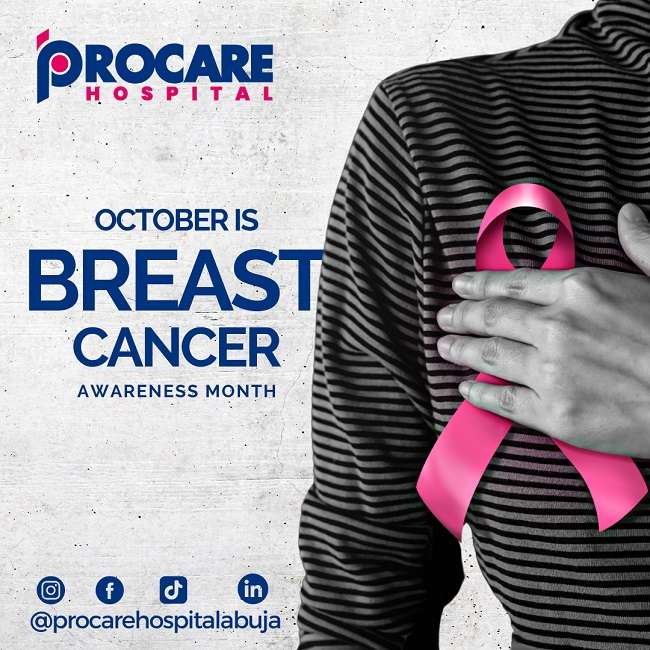Breast Cancer
Breast Cancer Awareness Month (BCAM) is celebrated every October since the nineties. It is called “Pink October” as people around the world adopt the pink colour and display a pink ribbon to raise awareness about breast health and the importance of screening for the early diagnosis of breast cancer.
WHAT IS CANCER?
An abnormal, uncontrollable, and continuous replication of cells.
WHAT IS BREAST CANCER?
- Malignant tumors developed from cells in the breast. Primarily diagnosed in women and rare cases can also be found in men.
- The second leading cause of cancer death in women.
- 1 in 10 women has breast cancer. On average, every 2 minutes a woman is diagnosed with breast cancer, and 1 woman will die of breast cancer every 13 minutes.
- Death rates are declining with early detection and increased awareness.
- In 2020, 2.3 million women worldwide were diagnosed with breast cancer, and 685 000 women died from it. There has been an estimated 7.8 million breast cancer diagnoses worldwide in the past five years(since the end of 2020 according to WHO), making it the most prevalent cancer in the world.
RISK FACTORS ASSOCIATED WITH BREAST CANCER
MODIFIABLE
- Overweight / Obesity.
- Lack of Excercise
- Smoking
- Birth Control Pills
- Excessive Alchohol Consumption
NON MODIFIABLE
- Positive Family History: One or more blood relatives with breast cancer or ovarian cancer.
- Genetic Predisposition: Has abnormal genes such as BRCA1 or 2 or PALB2 genes.
- Previous history of radiation exposure to the chest wall.
- Early Menarche (< 12yrs): Began menstrual period before the age of 12 years.
- Late Menopause: Menopause after the age of 55 years.
- Hormone Replacement Therapy (HRT) with estrogen and progesterone over a long period of time.
- Never had children or her first child after the age of 30 years.
SYMPTOMS OF BREAST CANCER
- A lump, hard knot, or thickening in the breast that feels different from the rest of the breast tissue.
- A lump under your arm/armpit.
- A change in the size or shape of the breast.
- A change in skin colour or texture such as dimpling, puckering, redness, or skin that looks like an orange peel.
- Breast Pain.
- Nipple retraction (turning inward or inverted)
- Nipple Pain or discharge (including a rash on the nipple, soreness of the nipple)
PREVENTION OF BREAST CANCER
LIFESTYLE MODIFICATION
- Maintaining a healthy weight
- Staying Physically active.
- No smoking
- Eating Fruits and Vegetables
- Alcohol consumption in limited quality.
EARLY DETECTION
- Have an early detection plan.
- If breast cancer is detected early, there is a 100% 5-year relative survival rate.
- The plan should include the following:
- 20 – 40 years: Have a clinical breast exam (CBE) by a healthcare professional at least every three years.
- At age 40, have an annual CBE and mammogram.
- If you are at high risk, talk with your healthcare professional about beginning your annual mammograms at a younger age and/or having an MRI scan.
- If you have a family history of breast cancer, talk to your healthcare provider about genetic testing.
- When you reach menopause, talk to your healthcare professional about whether you should have hormone replacement therapy.
- Know what is normal for your breasts. (Breast self-exam is one way you can do this). If you notice changes, see your healthcare professional right away.
SCREENING
- Breast Self-examination
- Clinical breast examination
- Mamogram
- Ultrasound
BREAST SELF EXAMINATION
Breast self-examination is a checkup a woman does at home. The best time to do a breast self-exam is about 3-5 days after your period starts. Check for changes/abnormalities while lying down, in the shower, and in the mirror.
- Place your left hand behind your head. With the fingers of your right hand, gently but firmly press down using small circular motions to examine the entire left breast. Feel your armpit.
- Also, perform the above while lying down position.
- Gently Squeeze the nipple, checking for discharge.
- Repeat the process on the right breast.
FAQS AND MYTHS ABOUT BREAST CANCER.
- “Only women with a family history of breast cancer are at risk”
- Roughly 70% of women diagnosed with breast cancer have no identifiable risk factors.
- “Most breast lumps are cancerous”
- 80% of breast lumps are benign (non-cancerous)
- “Breast Cancer is noncurable”.
- 90% of early-stage breast cancers are curable often with breast-conserving treatments.
- “Only women can get breast cancer”
- For every 135 cases of breast cancer in women, one man is diagnosed.
- “Small-breasted women have fewer chances of getting breast cancer.
- No connection between the size of breasts and the risk of getting breast cancer.
- “Breast Cancer always comes in form of a lump”.
- A lump may indicate breast cancer, but women should also be on the alert for other changes that may be a sign of cancer.
- “Having a risk factor means you will definitely get the disease”
- It just increases the chances of having breast cancer.
- “Annual mammograms expose you to radiation that increases your risk of breast cancer.”
- While it is true that radiation is used in mammography, the amount is so small that any associated risks are tiny when compared to the huge benefits (preventive benefits) reaped from the test.

